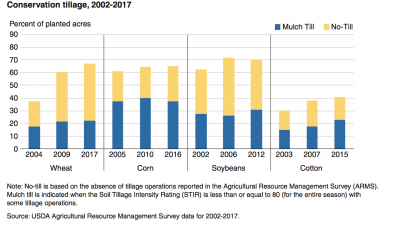Agriculture leaders in the United States House of Representatives are looking to provide at least an additional $10 billion in farmer aid to supplement the recently announced Farmer Bridge Assistance…
ERS Report: Tillage Intensity and Conservation Cropping in the U.S.
On Wednesday, the USDA’s Economic Research Service (ERS) released a report titled, “Tillage Intensity and Conservation Cropping in the United States,” which discussed regional and crop conservation tillage practices, as well as adoption of residue and cover practices. Today’s update highlights a few aspects of the report.
The ERS report, which was authored by Roger Claassen, Maria Bowman, Jonathan McFadden, David Smith, and Steven Wallander, stated that, “Conservation tillage—the use of tillage methods that disturb the soil less than ‘conventional‘ tillage—was originally promoted as a soil and water conservation technology…In recent decades, farmers have increasingly adopted conservation tillage methods for a broader set of reasons. In addition to reducing erosion and preserving soil moisture, conservation tillage can reduce crop production costs by reducing the use of fuel, labor, and tillage machinery. Herbicide- tolerant crops have increased the availability of pesticides for post-emergent weed control and further reduced reliance on tillage. Increasingly sophisticated planters equipped to cut through or clear crop residue from the row have made it easier to plant directly into untilled, residue-covered soil.”
“More recently, USDA’s Natural Resources Conservation Service (NRCS) has identified soil health as a key focus for soil management,” ERS explained.
“Conservation tillage, which protects the soil by reducing soil disturbance and keeping the soil covered, is considered to be a key component of a soil health management system.”
The report stated that, “Conservation tillage was used on a majority of wheat (67 percent in 2017), corn (65 percent, 2016), and soybeans (70 percent, 2012) in the most recent surveys. Conservation tillage was used on just 40 percent of cotton acres (2015).”

USDA, Economic Research Service. Roger Claassen, Maria Bowman, Jonathan McFadden, David Smith, and Steven Wallander (September 26, 2018).
“No-till accounted for more than 50 percent of conservation tillage acres on 2017 wheat (67 percent of conservation tillage; 45 percent overall) and 2012 soybeans (56 percent; 40 percent overall). Smaller proportions of conservation tillage were no-till on 2016 corn (42 percent; 27 percent overall) and 2015 cotton (44 percent; 18 percent overall).”

USDA, Economic Research Service. Roger Claassen, Maria Bowman, Jonathan McFadden, David Smith, and Steven Wallander (September 26, 2018).
The ERS authors also pointed out that, “Conservation tillage adoption also varies across regions…In corn, no-till adoption is greater in drier regions (Northern Great Plains, Prairie Gateway) and warmer regions (Prairie Gateway, the South)…[and]…No-till soybeans are most likely in warm regions (Prairie Gateway, the South) and seem to be more likely in portions of the north with higher rainfall (e.g., no-till is more likely in the Heartland and the Northern Crescent than in the Northern Great Plains).”

While discussing tillage practices over time, the ERS report explained that, “Soil health benefits of conservation tillage may be fully realized only when practices minimize soil disturbance (e.g., no-till, strip-till) consistently over time. Nonetheless, many producers alternate no-till or strip-till with tillage practices that disturb the entire soil surface (conventional or mulch-till).”
After analyzing data related to this issue, the authors indicated that, “Using these data, an estimated 21 percent of the combined acreage in the four surveys (corn, 2016; cotton, 2015; soybeans, 2012; and wheat, 2017) were continuously in no-till or strip-till in all 4 years. Continuous no-till/strip-till was most common in those fields where the surveyed crop was wheat. Continuous no-till/strip-till was least common where the surveyed crop was cotton.
“On an estimated 29 percent of land in the four crop surveys combined, producers used some combination of no-till or strip-till and full-width tillage (alternating no-till/strip-till). An estimated 50 percent of land across all four crops was continuous tillage (that disturbs the entire soil surface) in all 4 years. Continuous tillage was most common in the corn and cotton surveys.”

The ERS report also noted that, “The predominance of conservation cropping varies by crop and tillage practice.”

USDA, Economic Research Service. Roger Claassen, Maria Bowman, Jonathan McFadden, David Smith, and Steven Wallander (September 26, 2018).
After discussing other important aspects of conservation and soil health, the ERS report noted that, “There is some evidence to suggest that farmers who use no-till are also more likely to use conservation crop rotations and cover crops. These practices may be viewed, at least by some farmers, as complementary because of their combined effect on soil health and productivity. The relatively high rate of conservation crop rotations by corn producers may be largely due to the fact that corn is a high-residue crop and (unlike wheat, the other common high-residue crop) is often grown in rotation with a legume (soybeans), although a simple corn-soybean rotation would not meet all of the criteria for a conservation rotation. Practices that could lead to higher residue, including cover crops and double cropping, are less widely adopted on all crops. Some practices that reduce residue production or remove it from the field after harvest are adopted more often, including fallowing in wheat (20 percent of acres), residue grazing in corn (12 percent), and residue harvest in corn (7 percent) and wheat (4 percent). At present, there is little evidence to indicate whether farmers consider conservation tillage and residue practices to be complementary in production. That is particularly true for cover crop practices where adoption, although increasing, is still very low.”





